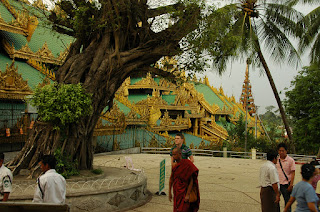Sometime at the beginning of 2012 Martin asked whether we would be interested in a cruise on the Irrawaddy. My face must have indicated both enthusiasm for a cruise and confusion as to the location. However, when the road to Mandalay was mentioned I realised we were talking Burma (now Myanmar).
The flight was via Singapore and as Helen wanted to catch up with a friend we opted to leave early and have a couple of nights stay. This gave us an opportunity to catch up on the latest developments and we walked around Marina Bay Sands shown here with the Helix bridge in the middle ground and sports park in the foreground.
The shopping area adjoining the Casino was very spacious and included a canal with Sanpans which flowed under the coffee shop.
The canal also formed part of a spectacular stormwater system.
way
We made our way up to the top of the Tower for lunch. What a view! These two structures are hot houses modelled on the Eden project in Devon.
Lunch was a long term commitment with plenty of great
wine and food interspersed with trips outside to take in the view. We arrived
in great weather and finished with deluges of rain and a violent electrical
storm. Helen and Larraine seemed to enjoy themselves regardless of the weather.
The following day we caught the flight to
Yangon which is the Southern end of Burma. The lack of machinery and dependence
on manual labour was immediately apparent.
It
was not long before we were also aware of the number and extent of Pagodas. We
quickly got into the routine of taking off and bagging our shoes. All pagodas
are on high ground and we were fortunate to be able to take a lift to the Shwe Dagon which is the largest in Yangon. As the heat and humidity would have made this a tough challenge. Pagodas are
covered in gold leaf which gets washed off during the regular downpours of the
wet season. The storm water run is carefully collected and the gold settled off
for re-use.
Some
of the pagodas have colourful worshipping areas.
Labour
is cheap ($1 goes a very long way). There is real enthusiasm for some work such
as distribution of the newspapers now that the regime appears to have turned a
significant corner.
It does not matter where you are the Brits
like their customs - tea for two. (Bring back colonialism?)
The 6 hour coach ride from Yangon to Paya
where we joined the Pandaw Orient was very exciting. The coach travelled quite
fast down a road barely wide enough for two vehicles. As no one (motor bikes or
cyclists) look behind them there was a good deal of hooting to announce our
arrival and suggestion that they should pull over. It was apparent why
travel insurance was compulsory for this trip.
The Irrawaddy (it means elephant) river has a large
height range between the wet and dry winter season. We travelled in late Autumn
and the river was dropping at some 2.5 inches per day. This was an opportunity
for the local stevedores. The blue bag is ours!
Pagodas and sunsets go together well
together:
When
the sun set the ships lights created an exotic ambience, this is outside our
cabin door.
Of major concern were the amount of logs
headed downstream, most of which were Teak. The story that these were from a
soon to be submerged dam catchment just did not add up with the number of
barges.
We stopped for a trip at Thayet-Myo and
were treated to a pony and trap ride. 30 traps made for quite a wagon train.
Sue and Martin went on ahead.
While we were a little slower out of the
gate due to our novice driver.

The Tamarind trees made quite a frame to the view of the ship. Our cabin is on the second deck just to the right of the cross bracing.
After all that trapping, cocktails on the
front deck were the order of the day. Sue had read about a local cocktail called Pagu club which
comprised Gin, Cointreau and orange juice. Seemed to work OK!
Later in the afternoon we were given a
presentation on the local Longhe (like a simple overlarge skirt) and how to wear it using various tucking in techniques. This included headware -
and the result Ninja Umpa!!!
Given the varying water levels and lack of infrastructure
the ship had to be self sufficient. This included mooring arrangements. The
deck hand holding the post down was later replaced with sand bags.
























No comments:
Post a Comment